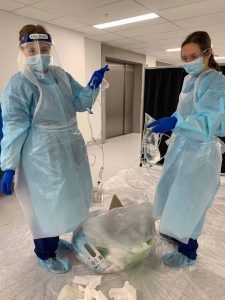A recent ‘Green Maternity Intervention’ program led by midwives at Western Health’s Joan Kirner Women’s and Children’s Hospital in Victoria resulted in a 71% decrease in clinical waste and a 48% reduction in waste management costs.
The project, which ran throughout 2021, was funded by the Executive Director of Nursing and Midwifery at Western Health through an annual midwifery research grant.
“Waste disposal is a significant cost to healthcare organisations and incorrect waste segregation, like putting unrecyclable items in recycling bins, can increase that cost,” explains Professor Linda Sweet, midwife researcher from Deakin University’s Institute for Health Transformation and Chair in Midwifery at Western Health, who steered the project with support from the Institute’s Dr Vidanka Vasilevski, and the team of midwives.
“We wanted to understand if a midwife-led intervention on improving waste management in a maternity hospital could help increase staff knowledge and reduce waste and waste management-related costs.”
While midwives value sustainable healthcare practices, factors such as high patient turnover, lack of time, inconvenient bin locations, and a perception that all waste is ‘clinical’ created challenges, Dr Vasilevski adds.
The intervention involved empowering midwife sustainability champions, education sessions, posters detailing correct waste preparation and disposal, monthly newsletters outlining key waste management strategies, and incentives to promote engagement.
Midwife and nurse Jessica Huynh was among staff who stepped up to become a Sustainability Champion because of her concerns over the amount of waste hospitals generate.

Prior to the project beginning, she says one of the biggest contributors to waste involved midwives opening up items like extra gauze, dressing packs, and IV cannulas, in preparation for obstetric emergencies, which then don’t always get used and end up in the bin. Inaccurate waste segregation was another issue, she reveals.
Staff were surveyed on their waste management knowledge and attitudes before and after the intervention.
A waste audit was also conducted at the beginning, middle, and end of the project to gauge whether the intervention resulted in improved segregation. Waste audit data found reductions in ‘clinical waste’ and that waste segregation improved from the beginning to the end of the intervention, resulting in a reduction in waste management costs.
“When tailored education is provided, effective waste segregation increases. Our findings suggest that targeted education about what items go into what bin is useful, and that the maternity staff found the instructional signage helpful,” Professor Sweet says.
“Having dedicated sustainability champions among the clinical staff – with allocated time to take on this role – was critical in encouraging behavioural change.”
Midwife Jessica says the intervention was well received among staff and resulted in noticeable change.
Monthly recycling themes included PVC recycling, clinical waste and sharps disposal, reducing waste in the staff tearoom, and reducing waste from baby care and feeding. Newsletters also communicated educational facts.
“Projects like this are important for a greener future. It just baffles me how much waste we contribute in healthcare and I think that even minor changes that we tried to implement helped make a difference.”
The research team is currently evaluating the initiative and the potential to roll it out on other wards at the hospital.
For interventions to be even more successful, and permanent, Jessica believes health services must employ a dedicated person to drive sustainability practices and monitor adherence.
“The acuity at our hospital is very high and it’s very hard to educate people when they’re in a hurry. If it’s an emergency they’re just going to do what they’re going to do.
“But if I think if there was someone in our maternity space who was communicating that information all the time and driving this change it would be possible to make an even bigger difference. Us on the floor working clinically, it was sometimes hard to survey all the changes and things people were doing.”
As for advice for nurses and midwives looking to embrace healthcare sustainability in their workplaces, Jessica suggests starting with something small and trying to secure some funding to help drive the changes. Having a business case always helps as well, as hospitals and health services are always looking at their bottom lines and trying to save money.








